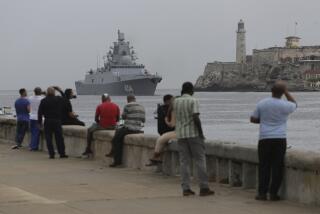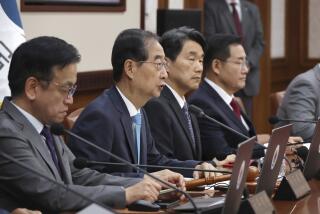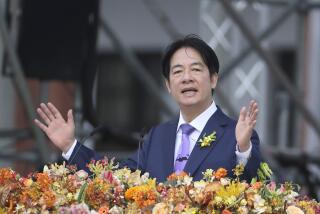U.S., South Korea enter second day of joint drills
Reporting from Seoul — A powerful four-day show of joint U.S. and South Korean sea and air power entered its second day without incident Monday, despite North Korea’s pledge to start a “sacred war” over the maneuvers.
Dubbed “Invincible Spirit,” the participants in the joint military exercises — featuring about 20 vessels, including the Nimitz-class aircraft carrier George Washington — left port just after dawn Sunday, shadowed by hundreds of U.S. and South Korean fighter jets.
The drills provided a potent reminder for the government in Pyongyang of the consequences of escalating tensions on the Korean peninsula. The exercises have been in the works since the March 26 sinking of a South Korean naval ship that killed 46 crewmen. An inquiry led by South Korea concluded that the ship was struck by a North Korean torpedo; North Korea has denied involvement.
Pyongyang has criticized the military maneuvers — the largest launched by the U.S. and South Korea since 1976 and the first to include the F-22 Raptor stealth fighter jet in South Korean airspace — and threatened to start a “retaliatory sacred war.” North Korea also has put its military and residents on high alert, according to local media.
The maneuvers, involving more than 8,000 service members from the U.S. and South Korea, were witnessed by four officers from Japan’s Maritime Self-Defense Forces, officials here said. In the coming days, the war games will include “a drill for infiltration by submarines,” according to an official for the South Korean Joint Chiefs of Staff who requested anonymity.
The March sinking of the naval patrol ship Cheonan, which Seoul called the worst military attack since the end of the Korean War, prompted the investigation by an international team of experts that ended up implicating the North.
Although condemning the incident, the United Nations Security Council stopped short of naming North Korea as the perpetrator. Still, international pressure has been building to punish strongman Kim Jong Il’s regime for the incident.
After a visit last week to the heavily armed demilitarized zone, which divides the two Koreas, Secretary of State Hillary Rodham Clinton announced that the U.S. would impose new sanctions on the North in retaliation for the Cheonan attack. Days later, the European Union suggested that it too would consider new sanctions against Pyongyang.
The military drills, initially scheduled to take place in the Yellow Sea, were moved to the Sea of Japan after China complained about the presence of the 97,000-ton George Washington, a symbol of U.S. military might with about 5,000 crewmen and a capacity to carry dozens of aircraft, including F-18 fighter jets.
On Saturday, the North Korean military denounced the games in a statement read on Korean Central Television in Pyongyang, saying the drills by “the U.S. imperialists and the South Korean puppet forces deliberately push the situation to the brink of war.”
Although termed defensive in nature, the exercises were expected to include firing artillery, dropping anti-submarine bombs and air-to-air refueling, South Korean officials said.
Capt. Ross Myers, commander of the George Washington’s air wing unit, called the maneuvers an effort to maintain “peace and stability” on the Korean peninsula but told the Yonhap news agency in Seoul on Sunday that such a powerful military presence was seen as a threat by Pyongyang, which considered such drills a rehearsal of invasion.
Said Myers: “North Korea doesn’t want these exercises.”
Park is a researcher in The Times’ Seoul Bureau.
More to Read
Sign up for Essential California
The most important California stories and recommendations in your inbox every morning.
You may occasionally receive promotional content from the Los Angeles Times.











